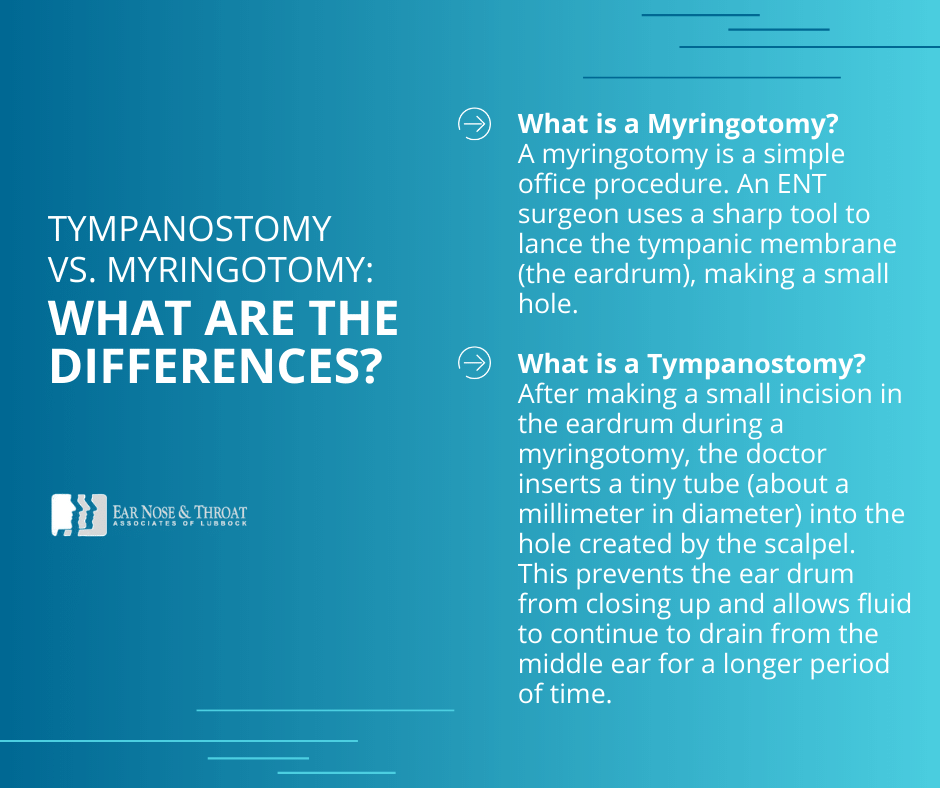Tympanostomy vs. Myringotomy: Differences Explained

Tympanostomy vs. myringotomy. If you’re not familiar with medical lingo, those words probably sound like gibberish!
But if you or your child suffer from frequent middle ear infections, you may have run across one or both of these terms in the past.
Is a myringotomy the same thing as a tympanostomy? And which procedure would be appropriate for your situation? You’ve come to the right place.
Why Would I Consider a Tympanostomy or Myringotomy?
The vast majority of these procedures are performed on young children, most of them under the age of two. The unfortunate truth is that the human eustachian tube (the small tunnel that connects the back of the throat to the middle ear) doesn’t always work very well, especially in little kids.
Normally, when you swallow food, drink, or saliva, air enters the middle ear from the back of the throat via the eustachian tube, ventilating the space. A healthy eustachian tube is open, and air and fluid are allowed to drain through it, so ear pressure remains normal.
But when you experience eustachian tube dysfunction, this passageway can become swollen or blocked due to infection or inflammation. Air and fluid build up in the ear, leading to pain, pressure, and other unpleasant symptoms.
Both a myringotomy and tympanostomy help to ventilate the middle ear when the eustachian tube falls down on the job.

Tympanostomy vs. Myringotomy: What Are the Differences?
What Is a Myringotomy?
A myringotomy is a simple office procedure. An ENT surgeon uses a sharp tool to lance the tympanic membrane (the eardrum), making a small hole.
This new opening allows the middle ear to ventilate and drain externally, through the outer ear, since the eustachian tube is blocked. The eardrum will heal itself within two weeks of the procedure, so it’s a short-term solution.
A myringotomy can be a good option for patients with a temporary eustachian tube blockage. This might be someone who developed fluid in their ears after experiencing a bad head cold or flying on a plane, for example.
The vast majority of patients experience immediate relief from a myringotomy.
What Is a Tympanostomy?
You can think of a tympanostomy as an “add on” procedure to the myringotomy. You can’t have a tympanostomy without first having a myringotomy!
When a eustachian tube problem is long-term or recurring, or if fluid persistently refuses to drain from the middle ear, a tympanostomy could be necessary.
After making the small incision in the eardrum during a myringotomy, the doctor inserts a tiny tube (about a millimeter in diameter) into the hole created by the scalpel. This prevents the ear drum from closing up and allows fluid to continue to drain from the middle ear for a longer period of time.
A tympanostomy is frequently performed on young children to prevent recurrent ear infections.
How To Make the Decision
In addition to all the symptoms mentioned above, a poorly ventilated middle ear can also cause retraction of the eardrum and even eventually damage the bones in the ear. The bottom line is this: an ear that isn’t properly ventilated isn’t a healthy ear.
Deciding between a tympanostomy and a myringotomy is a matter of determining whether you need short-term or long-term relief from pressure and fluid buildup.
For an adult dealing with an acute ear infection with a lot of pain and pressure who needs quick relief, a myringotomy should do the trick.
But for a child or adult dealing with chronic ear infections or fluid buildup, a tympanostomy will likely be the better solution.
You can discuss your specific situation with an ENT specialist to determine what the best course of action is for you.
Suffering From Repeated Eustachian Tube Blockages?
Our ENT physicians are experts in eustachian tube dysfunction and ear infections, and have extensive experience performing both tympanostomies and myringotomies on patients of all ages.
Our entire office team is here for you and your family. Reach out today to discuss your situation and which of these procedures might be right for you.
Dr. Scolaro is a board-certified Otolaryngologist servicing the South Plains area. He has been practicing in Lubbock since 1990 and has earned a reputation as a skilled and experienced surgeon. He currently serves as the Medical Director for Covenant High Plains Surgery Center campuses, is a member of Covenant Health Partners and is an adjunct faculty professor for Texas Tech University Health Sciences Center School of Medicine. Learn more about Dr. Scolaro.
Categories:








